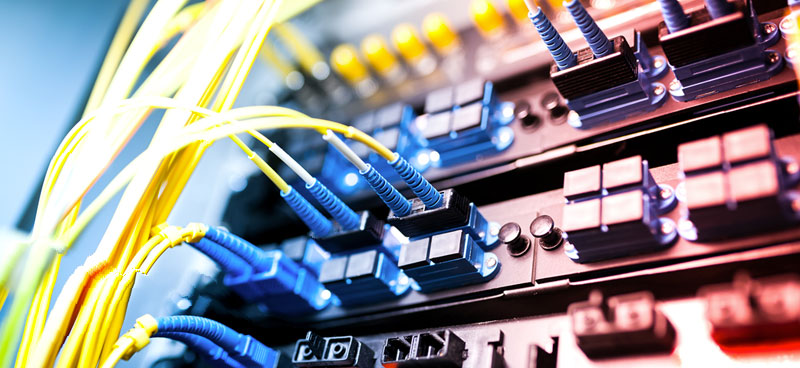What is Interconnect & Cross Connect
When you are making the decision to house your equipment and information in a colocation facility, space and power needs are top of mind. Still, it is just as critical to understand the different network interconnection options available to you so that your customers and business users are able to access your computational power and stored data. In fact, the ability to interconnect with the ecosystem of service providers within a given data center is a core benefit of colocation. There are two basic configurations when it comes to connections between the horizontal cabling and active equipment such as switches which are interconnect and cross-connect.
Unlike in-house data centers, colocation data centers aggregate networks, internet service providers (ISPs), content providers, cloud service providers, internet exchanges, and other customers or partners that your business is able to interconnect with. To optimize your network and hybrid architectures, you need to go beyond knowing which service providers are available and understand the details of each type of connection. Below is a description of the most common types of connections and their most salient attributes. There are two basic configurations when it comes to connections between the horizontal cabling and active equipment such as switches which are interconnect and cross-connect.
An interconnect (generally speaking) is a physical or logical connection between two electronic devices or networks. Expressed as a verb, to interconnect is to establish a connection between two separate electronic networks. In the United States, the term “interconnection” is identified as “the linking of two or more networks for the mutual exchange of traffic”.
In telecommunications, interconnection(Two-connector Interconnect) is the physical linking of a carrier’s network with equipment or facilities not belonging to that network. The term may refer to a connection between a carrier’s facilities and the equipment belonging to its customer, or to a connection between two or more carriers. In an interconnect design patching is done directly between the active equipment and the Distribution patch panel(s). This design is quicker, easier and cheaper to deploy than a Cross Connect design and requires less rack space, something that may be a consideration in communication Rooms with limited space. It is, however, less secure as patching technicians must have access to both the active equipment and passive patch zone.

This above connection can be shown in a rack level as below,

A cross-connect is a physical, hardwired cable that provides a direct connection between two different termination locations(patch panels) within a data center. Cross-connects are the physical or virtual connections from one facility to another(two providers). In a cross-connect design the switch ports are replicated on to an Equipment patch panel and patching is carried out between the equipment patch panel(s) and the Distribution patch panel(s). The Switch Links between the active equipment and the equipment patch panel can be either solid core or stranded cable, depending on any channel length limitations or the suitability of the equipment patch panel terminations to accept stranded conductors.

Cross connects had mainly been on copper (Cat5e/6 etc.) but recently a large amount are on fiber cables to carry the bandwidth. Your cross connect options include,
- Fiber
- Coaxial
- Copper(CAT5/CAT6)
- POTS
Basically there are two types of cross-connects, which are three-connector cross-connect and four-connector cross connect.
The following picture shows a basic cabling structure of a three-connector cross connection. In this picture, three RJ45 patch panel is being used. This structure is like the above mentioned interconnection, just a cross-connecting process is added at the switch end.

Four-Connector Cross Connect is a more complex network structure, which is a commonly used four-connector cross connection. This type of connection usually requires a patch field which is usually cabinet. In this case, two copper trunk cables are working as permanent cables. Patch cords are used at this cabinet to connect the devices. Four patch panels are used. There is an individual cabinet for cross connection.

Essentially it’s called cross-connect because it’s a dedicated cable from one rack to another – the idea is it doesn’t go through any other network switches or anything(reducing the number of hops) that could introduce extra latency, a single point of failure or risk impacting the service to other users.
A cross connect cabling offers a variety of benefits. Most importantly it involves a dedicated patching area that makes moves, adds and changes easier to manage. The patching area isolates mission critical active equipment, so there is less risk of disrupting live circuits while servicing the patch panels. Additionally, cross connects to carriers and cloud providers can also save money, improve reliability, and add versatility to your network. The drawbacks are that this design requires more rack space and more cabling components, with more labor required for their installation, all of which adds up to higher costs.
As a summary of this article I would like to add this words too, according to TIA/EIA-568A, a cross connect is a facility enabling the termination of cable elements and their interconnection, and/or cross connection, primarily by means of a patch cord or jumper. A cross connection is a connection scheme between cabling runs, subsystems, and equipment using patch cords or jumpers that attach to connecting hardware on each end; an interconnection is a connection scheme that employs connecting hardware for the direct connection of a cable to another cable or to an equipment cable without a patch cord or jumper.
Knowledge Credits : Fiber Optic Tutorials
Have a comment or points to be reviewed? Let us grow together. Feel free to comment.

